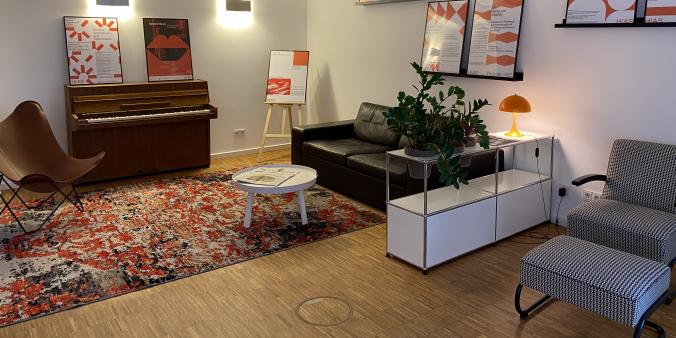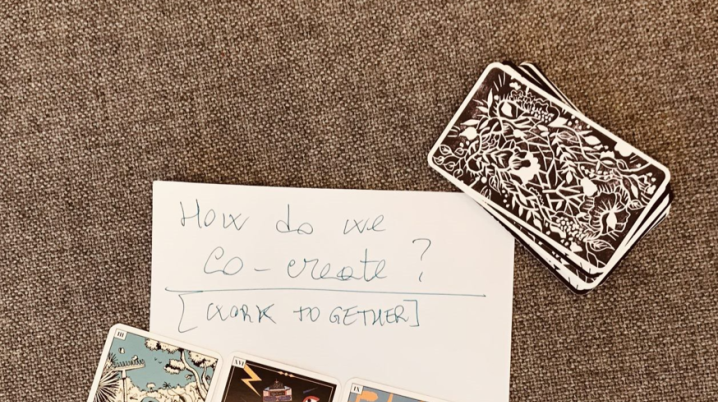
Methodological Highlight: Archetypes for a Journey
The inaugural meeting of the Residencies Research Group– Kathryn Roberts, Pau Cata, Miriam la Rosa, Patricia Healy McMeans, Angela Serino and Bojana Panevska– convened in Hamburg in July 2023, as hosted by the Hamburg Institute of Advanced Study (HIAS). Following on from our first post, more generally about our experiences in Hamburg, we offer this peek into our methodology of working together as a new cohort.
This week-long residency about residencies was the first in a series of four research residencies over a three-year period (2023-2025), and is supported by the Constructive Advanced Thinking (CAT) Program. In this blog, we will share updates from the project as it develops, facilitated by the knowledges, networks, and built environments of our host institutions: Hamburg Institute of Advanced Studies (HIAS), Madrid Institute for Advanced Study (MIAS) / Casa de Velasquez (CVZ), and Montpellier Advanced Knowledge Institute on Transitions (MAK’IT).
Our first day in the workspace graciously provided to us by Lola and her colleagues at HIAS, which holds an entire floor of a quiet office building in a leafy neighborhood, was spent getting to know the space, and each other. Coming from the U.S., Australia, the Netherlands, and Catalonia, and across academic and practical perspectives in the field, we had never all been in situ in one place at one time before. We were excited, and a bit tentative, wondering how do we all fit in, and fit in together? Whilst we had planned to begin our week giving attention to each other through a short presentation or slidedeck in order to share our unique best practices and approaches to artists residencies, we opted to kickstart our week- and project together- by engaging more open processes, beyond language, and also invite in a little bit of magic.
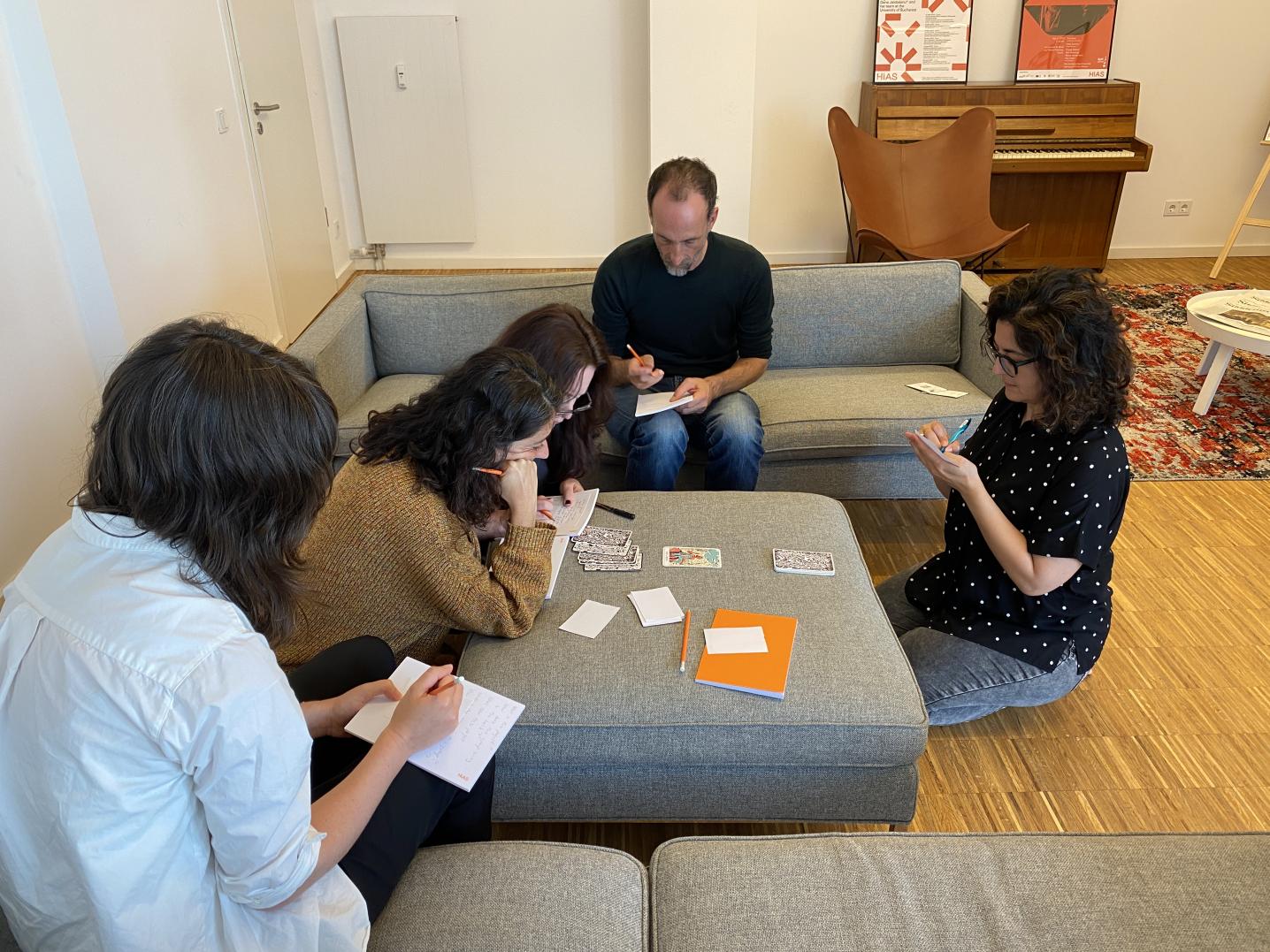
To begin, we formulated a central research question, one which we would use to ask a tarot deck a series of prompts. The question we collectively mustered was: How are we to co-create this project together over three years?
Angela led us through the tarot reading, drawing from an experimental collaborative tool developed by a project called RESHAPE, of which Pau was a member. This bespoke card deck is inspired by the traditional tarot, and crafted by artists and designers situated in Europe and the Mediterranean region.
These tarot cards offer a way for creative groups to engage in intuitive reflections and, through dialogue, explore ideas for how and why the cohort itself has come together, what each person brings, how to encourage resources, and various points of focus for the collaborative work.
For an entire day, we immersed ourselves in this exercise, gathered around a coffee table and a footstool, scattered about on couches. We chose to do the 'Four Advice Card' read of it, as used traditionally in the tarot and also especially outlined in the RESHAPE manual. The first card drawn is read as the beginning, the introspection of what each of us brings to the group. The second card is read as prompting answers about combined resources, while the third and fourth cards prompt fears or expectations and speculates alternative outcomes.
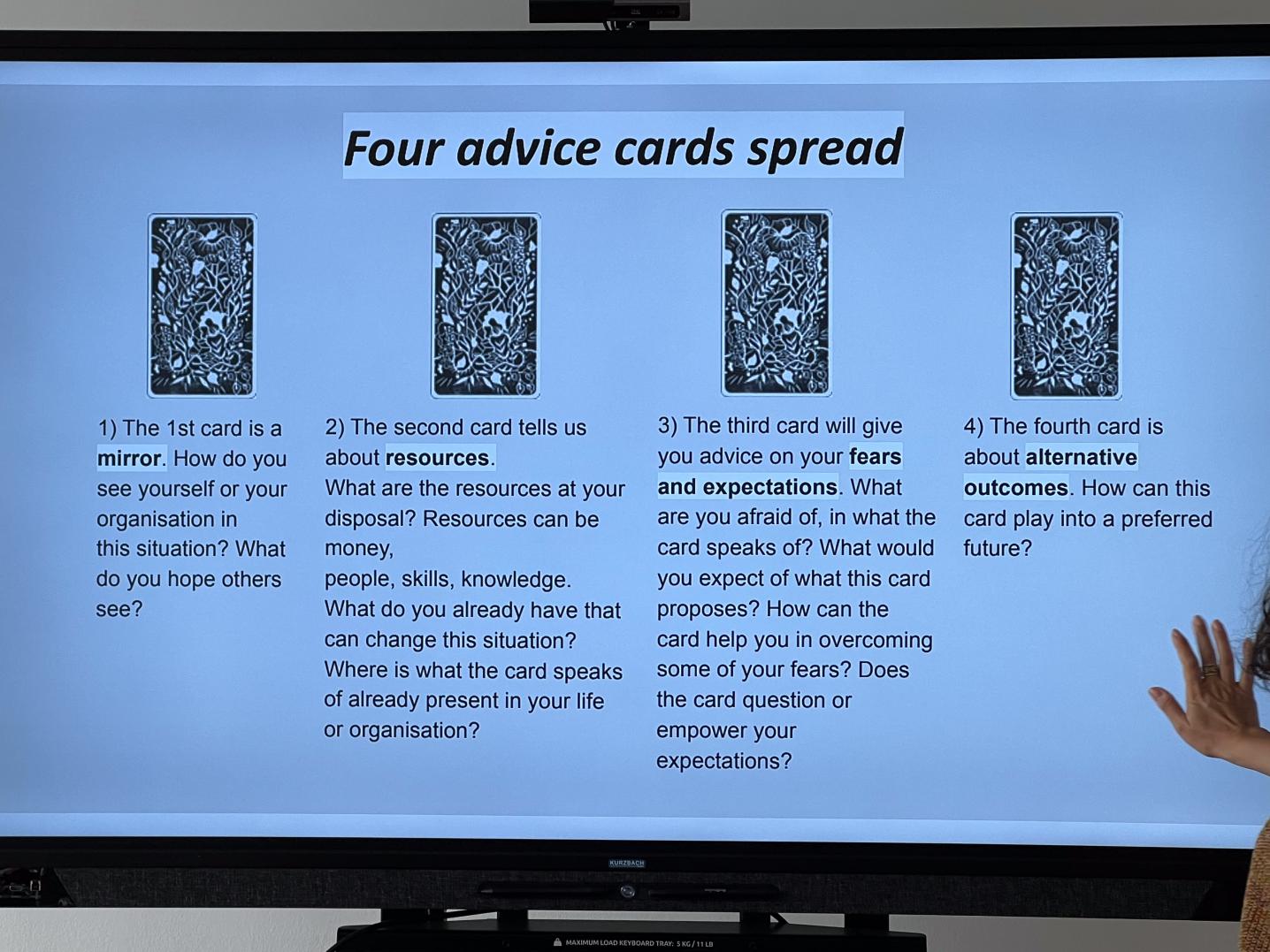
After describing the prompt, and all of us collectively meditating on it for one full minute, Angela, our psychic for the day, would pause. We held our collective breath for her to draw the next card. In one motion, we would all dive forward from our seats of repose, to examine and exclaim over what the universe had just given us: this postcard-size meticulous and detailed illustration, laying squarely in the center of the footstool. Ah! The first card: The Garden! We could suddenly now imagine our beginning as a garden.
After our exclamations, we would then remain on our knees, silently, observing the card and scribbling in our notes our initial reactions and observations of the illustration itself - such as color and line, and of course, imagery and placement. Then, we would go round and share aloud these observations and make connections between them, and us, and what the card might mean. Angela would then read from the manual, as each card has behind it a deep description, an archetype, and sometimes, a ritual involved.
Ah! The first card: The Garden!
The first card prompted us to delve into the garden of introspection: "How do we perceive ourselves in this scenario? And what do we aspire for others to perceive?"
Illustrated by the archetype of the Garden, depicted as a youthful gardener amidst a seemingly untamed garden teeming with various creatures, this imagery evoked the notion of a multifaceted ecosystem—a system capable of self-sustenance through self-organization and interrelation, embodying a narrative of perpetual metamorphosis. We couldn't help but notice the serene countenance of the young gardener, prompting us to ponder the secret behind such tranquility.
This card served as a catalyst for our discourse, steering us towards a contemplation of ways to "unearth the wilderness and cultivate its preservation." It urged us to "embrace complexity," spanning across diverse geographies and species, with a specific emphasis on methods fostering attunement to the context. Unanimously, we acknowledged the imperative of challenging dominant narratives through the adoption of non-representational methodologies—such as tracings, renderings, micro-narratives, and anarchist geography—as means to disrupt established paradigms and encourage alternative perspectives.

The second card: Shock
The second card prompted a reflection on resources, posing questions such as: "What assets are available to us? What existing elements possess the potential to catalyze change? Where do we already witness echoes of the card's message in our lives?" The archetype unveiled was The Tower.
For some among us, the depiction of "shock" seemed suspended between chaos and grace. Despite the initial terror evoked by the imagery, a closer examination revealed a subtler narrative—a delicate interplay of elements. It appeared as though the various components on the card—the crimson tongue, the eyes, the cascading shapes amidst the thunder, and the animals at the tower's base—were engaged in a collective dance.
The card spoke to us of an (art) institution in upheaval, characterized by fissures and openings, shedding its identity as an isolated tower in favor of porous boundaries. We interpreted the cracks in its walls as opportunities for transformation. The destruction of the tower signified not an end but rather a commencement—a moment of renewal and regeneration, heralding the dawn of a new era.
The third card: Resourcing
The third card delved into our fears and expectations, prompting introspection with inquiries such as: "What are our apprehensions? How might the card guide us in overcoming these fears? Does the card challenge or bolster our expectations?" The archetype revealed was Resourcing.
Captivated by the enigmatic central figure of the card—a torch-bearer with four hands, set against a backdrop of intertwined branches—we contemplated the notion of support structures. We pondered on the question of "sustaining structures that in turn sustain us." What frameworks are necessary to alleviate concerns about overproduction or the physical and emotional strain often associated with collaborative endeavors?
This imagery led us to consider how we can cultivate supportive systems that not only provide stability but also nurture our well-being amidst the rigors of collective work. We recognized the importance of establishing structures that offer respite from the anxieties of excessive output and the fatigue that can accompany collaborative efforts.

The fourth and last card: The Mirror
The fourth and final card centered on exploring alternative outcomes, prompting us to envision a desired future. The Mirror emerged as the archetype guiding our reflections.
This card presented us with a whimsical tableau: a mirror that diverges from convention, resembling instead the porous surface of black coral or the rigid contours of a colossal leaf. Its imagery evoked notions of hidden truths and symbolic depths, perhaps hinting at uncharted territories like "witch-histories" waiting to be unearthed.
We were encouraged to seek out multiple perspectives and delve into the minutiae—the lesser-known elements—both within and around us. These overlooked details might hold the key to envisaging alternative pathways. We pondered over the notion of identifying "the detail that holds the CAT assemblage together," akin to finding the elusive key tucked beneath the dish beneath the brick—discovering the subtle yet pivotal elements that underpin our collective existence.
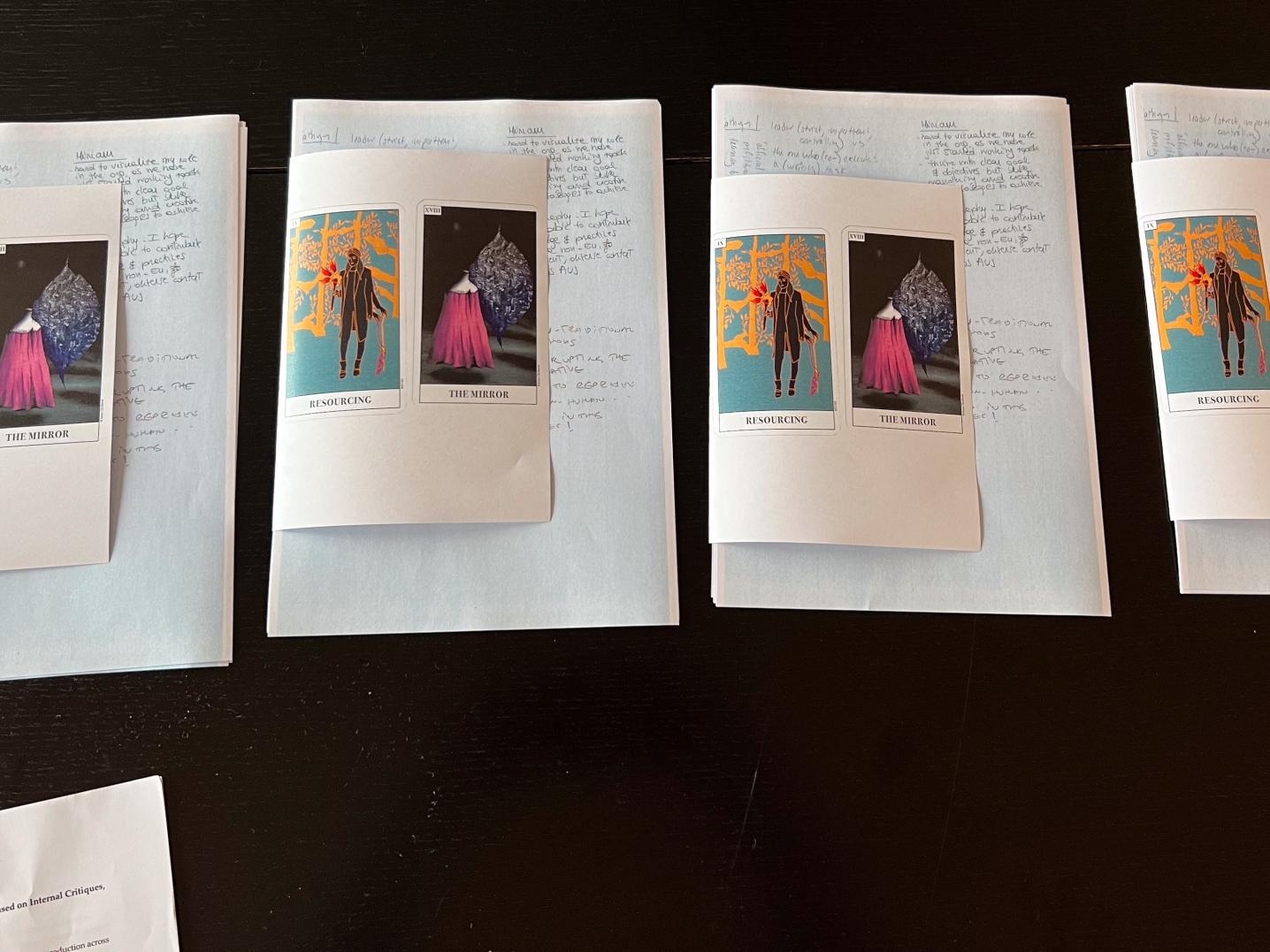
Through this tarot reading we eagerly anticipate witnessing the unfolding of their messages as our project evolves and matures over time. With each step forward, we anticipate delving deeper into the mysteries the cards hold, uncovering new layers of insight and understanding.
These Archetypes for a Journey serve as gateways to transformative experiences, guiding us on a journey of discovery and exploration. They are not merely static symbols, but living entities, evolving alongside us as we delve deeper into the realms of knowledge and inquiry. As we navigate the twists and turns of our research endeavor, we anticipate encountering moments of connection and revelation.
As we embark on this journey together, we do so with a sense of anticipation and excitement, knowing that each encounter will propel us further along our path of discovery.
After many online meetings and working together across the continents, the CAT group will meet again on 8-15 September in Madrid at Madrid Institute for Advanced Study (MIAS) / Casa de Velasquez (CVZ).
Stay tuned for more posts and insights!
